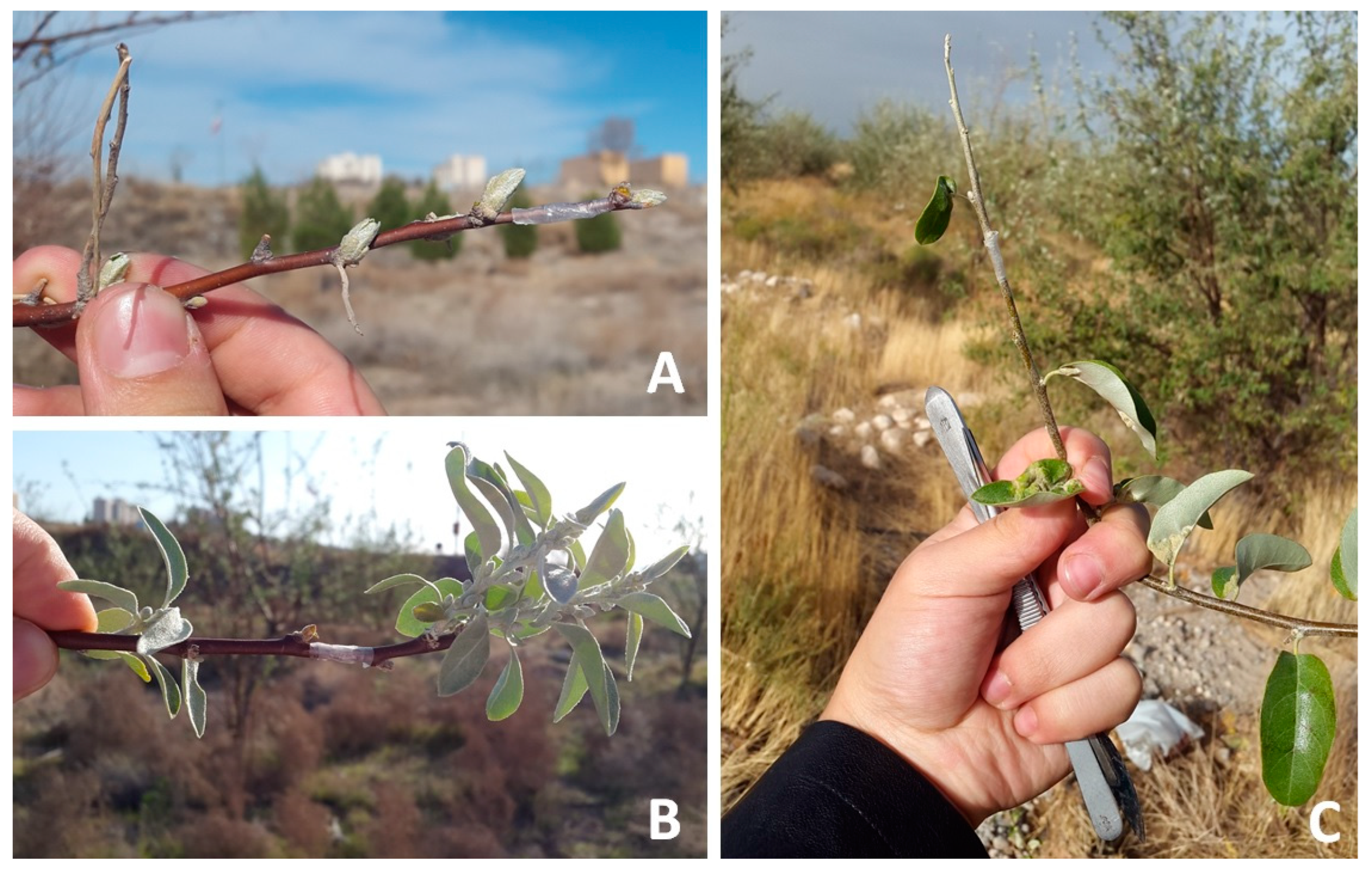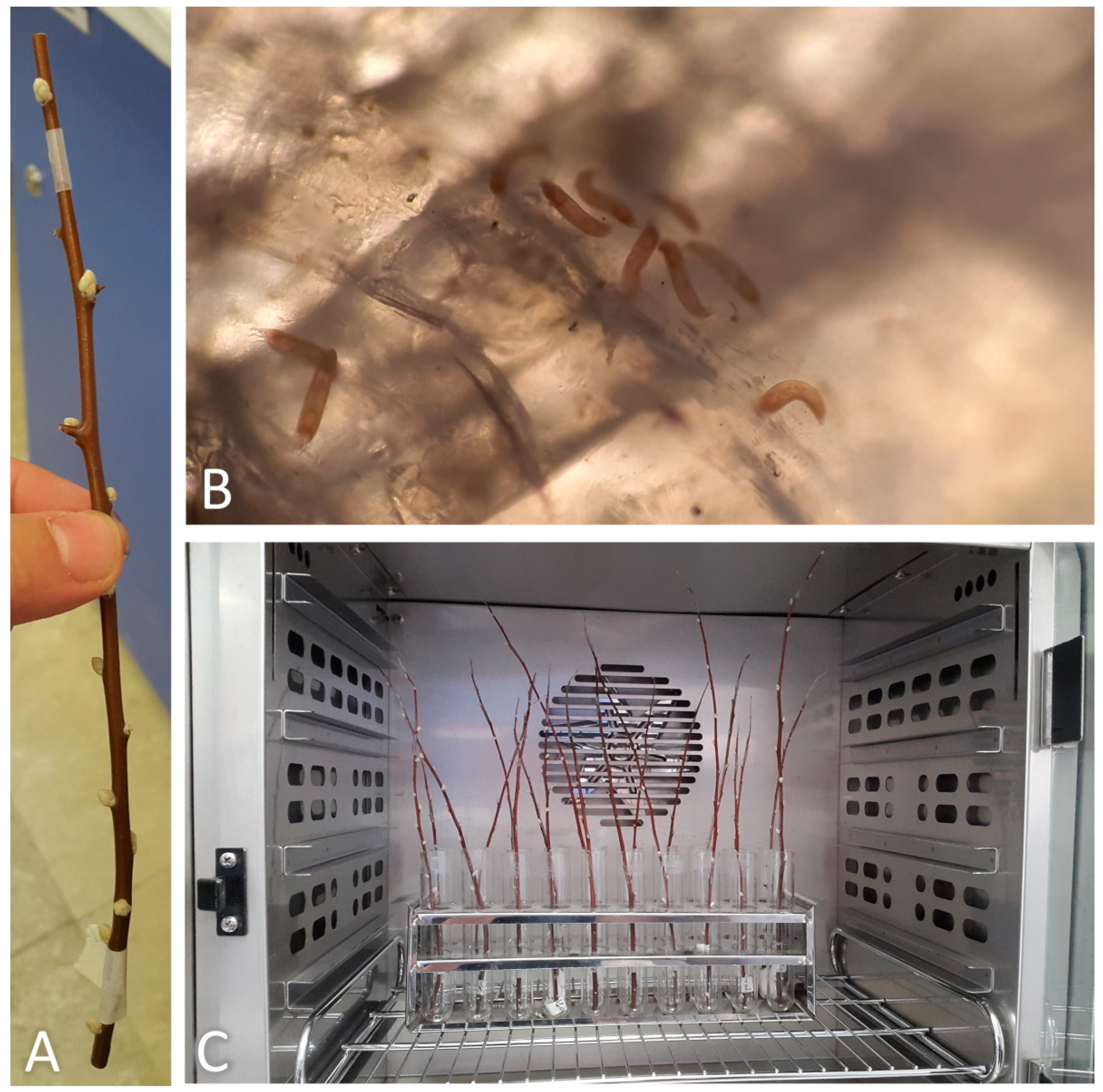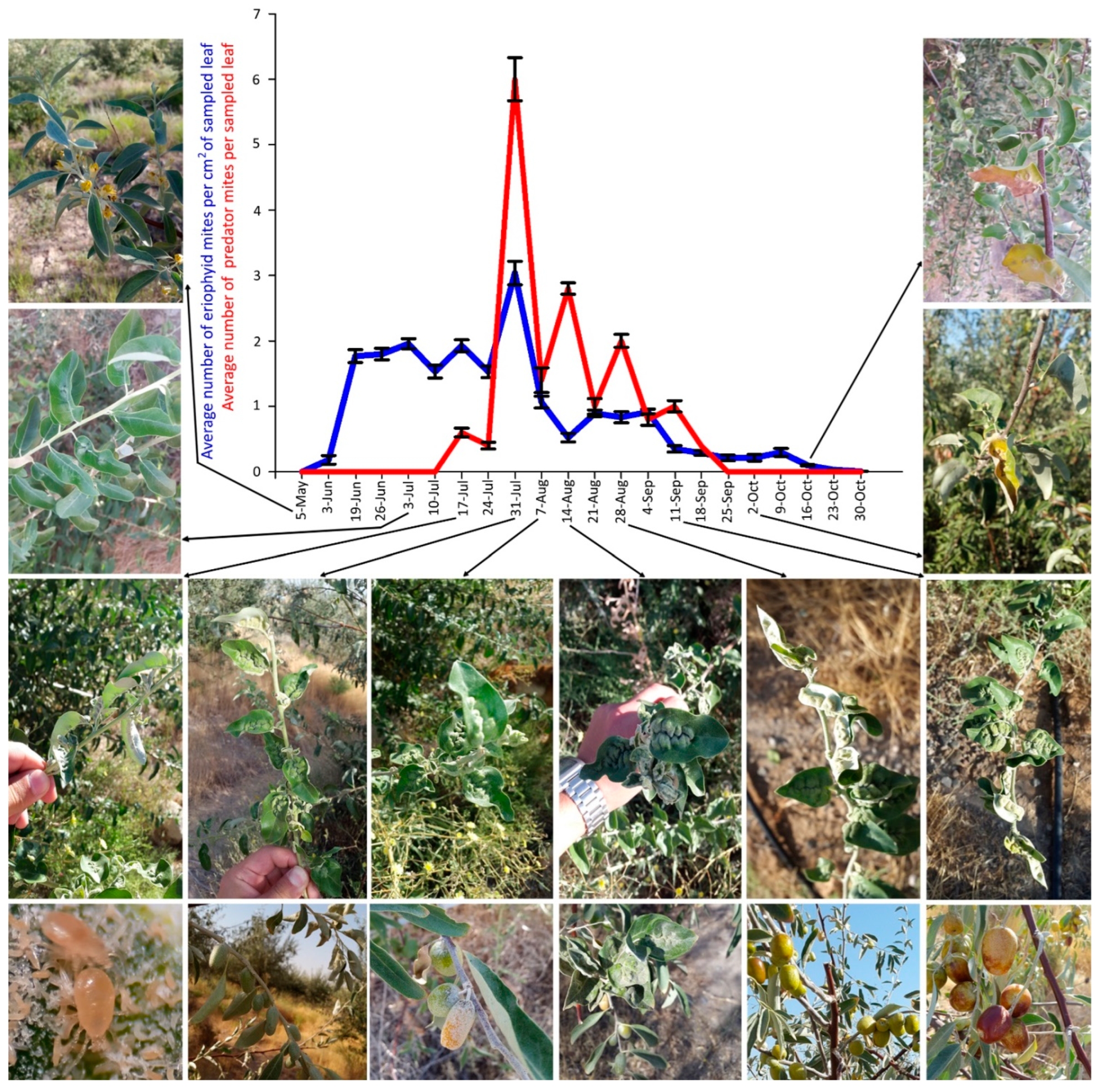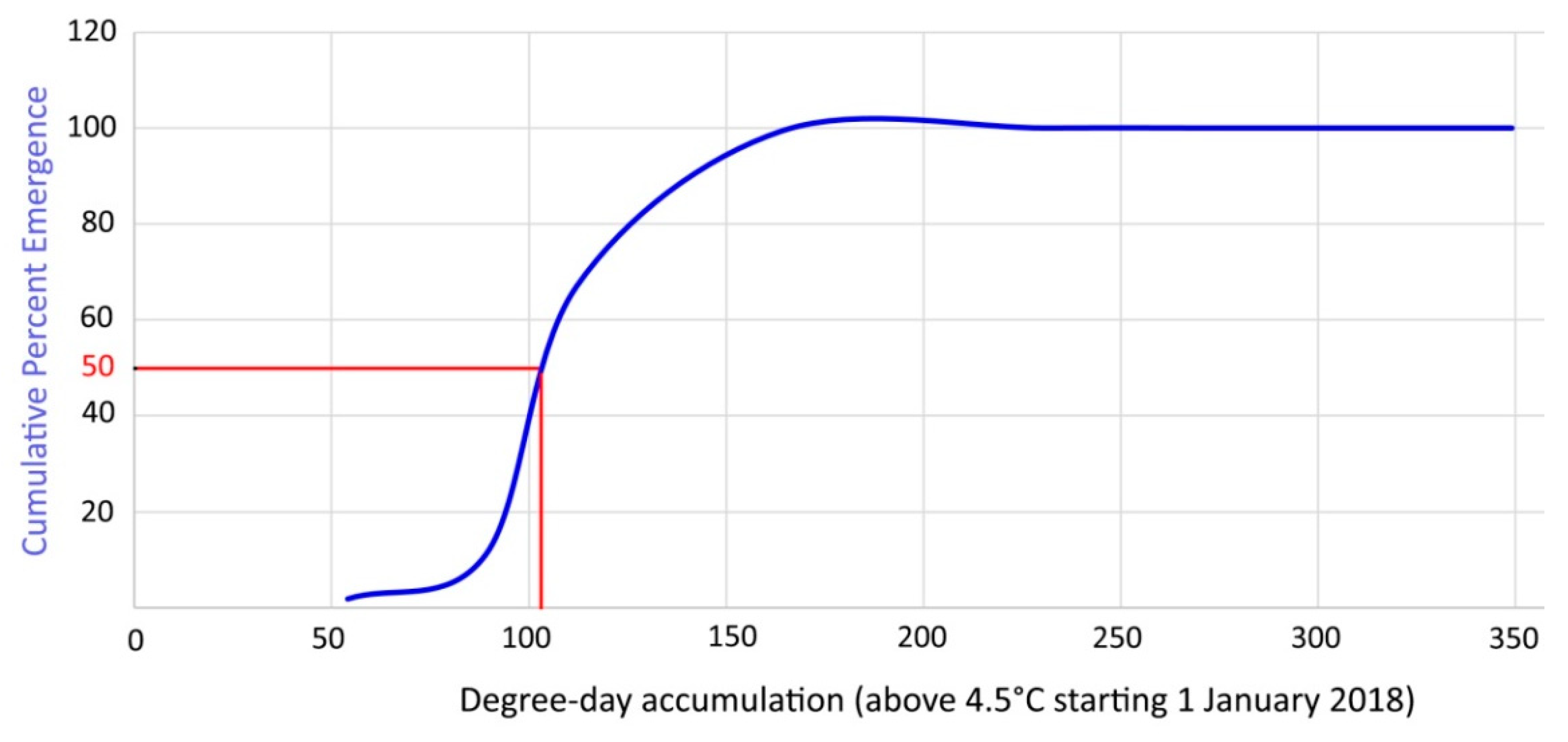Field and Laboratory Observations on the Biology of Aceria angustifoliae with Emphasis on Emergence of Overwintering Mites
Abstract
:Simple Summary
Abstract
1. Introduction
2. Materials and Methods
2.1. Field Observations: Population Dynamics of Overwintering Mites
2.2. Field Observations: Phenology of Mite Emergence
2.3. Field Observations: Mite Population Dynamics on Leaves
2.4. Field Observations: Migration to Overwintering Sites
2.5. Laboratory Observations: Emergence of Overwintering Mites at Constant Temperatures and Degree-Day Calculation
2.6. Further Statistical Analysis
3. Results
3.1. Field Observations: Population Dynamics of Overwintering Mites
3.2. Field Observations: Phenology of Mite Emergence
3.3. Field Observations: Mite Population Dynamics on Leaves
3.4. Field Observations: Migration to Overwintering Sites
3.5. Laboratory Observations: Emergence of Overwintering Mites at Constant Temperatures and Degree Day Calculation
4. Discussion and Conclusions
Supplementary Materials
Author Contributions
Funding
Institutional Review Board Statement
Data Availability Statement
Acknowledgments
Conflicts of Interest
References
- Denizhan, E.; Monfreda, R.; de Lillo, E.; Çobanoğlu, S. Two new species of eriophyoid mites (Acari: Eriophyoidea) associated with Elaeagnaceae in Turkey. Zootaxa 2008, 1698, 41–48. [Google Scholar] [CrossRef]
- Weyl, P.; Asadi, G.A.; Cristofaro, M.; Vidović, B.; Petanović, R.; Marini, F.; Schaffner, U. The host range and impact of Aceria angustifoliae (Eriophyidae), a potential biological control agent against Russian olive, Elaeagnus angustifoliae (Elaeagnaceae) in North America. Biocontrol Sci. Technol. 2019, 30, 85–92. [Google Scholar] [CrossRef]
- Schaffner, U.; Zaquini, L.; Cristofaro, M. Biological Control of Russian Olive, Elaeagnus Angustifolia; Annual Report VM10015; CABI-Europe Switzerland: Delémont, Switzerland, 2011; 17p. [Google Scholar]
- CABI. Weed Biological Control; Progress Report 2022; CABI: Delémont, Switzerland, 2022; 28p. [Google Scholar]
- Zou, L.; Stout, M.J.; Ring, D.R. Degree-Day Models for Emergence and Development of the Rice Water Weevil (Coleoptera: Curculionidae) in Southwestern Louisiana. Environ. Èntomol. 2004, 33, 1541–1548. [Google Scholar] [CrossRef] [Green Version]
- Westigard, P.H. Population Injury Levels and Sampling of the Pear Rust Mite on Pears in Southern Oregon13. J. Econ. Èntomol. 1975, 68, 786–790. [Google Scholar] [CrossRef]
- Arzone, A. Esperimenti di lotta biologica contro Phytoptus avellanae Nalepa in Piemonte (Acarina, Eriophyidae). Inform. Fitopatol. 1977, 27, 29–32. [Google Scholar]
- Bergh, J.C.; Judd, G.J.R. Degree-Day Model for Predicting Emergence of Pear Rust Mite (Acari: Eriophyidae) Deutogynes from Overwintering Sites. Environ. Èntomol. 1993, 22, 1325–1332. [Google Scholar] [CrossRef]
- Zalom, F.; Wilson, L.T.; Goodell, P.B. Degree-Days: The Calculation and Use of Heat Units in Pest Management; Division of Agriculture and Natural Resources, University of California: Los Angeles, CA, USA, 1983; p. 11. [Google Scholar]
- Herms, D.A. Using degree-days and plant phenology to predict pest activity. In IPM (Integrated Pest Management) of Midwest Landscapes; Krischik, V., Davidson, J., Eds.; Regents of the University of Minnesota, Minnesota Agricultural Experiment Station Publication SB-07645: Minneapolis, MN, USA, 2004; pp. 49–59. [Google Scholar]
- Ullah, M.S.; Haque, A.; Nachman, G.; Gotoh, T. Temperature-dependent development and reproductive traits of Tetranychus macfarlanei (Acari: Tetranychidae). Exp. Appl. Acarol. 2012, 56, 327–344. [Google Scholar] [CrossRef] [PubMed]
- Ullah, M.S.; Kamimura, T.; Gotoh, T. Effects of Temperature on Demographic Parameters of Bryobia praetiosa (Acari: Tetranychidae). J. Econ. Èntomol. 2020, 113, 211–221. [Google Scholar] [CrossRef]
- Lin, M.-Y.; Lin, C.-H.; Lin, Y.-P.; Tseng, C.-T. Temperature-dependent life history of Eutetranychus africanus (Acari: Tetranychidae) on papaya. Syst. Appl. Acarol. 2020, 25, 479–490. [Google Scholar]
- Saeidi, Z.; Nemati, A. Almond spider mite, Schizotetranychus smirnovi (Acari: Tetranychidae): Population parameters in laboratory and field conditions. Pers. J. Acarol. 2020, 9, 279–289. [Google Scholar]
- Walton, V.M.; Dreves, A.J.; Coop, L.B.; Jones, G.V.; Skinkis, P.A. Developmental Parameters and Seasonal Phenology of Calepitrimerus vitis (Acari: Eriophyidae) in Wine Grapes of Western Oregon. Environ. Èntomol. 2010, 39, 2006–2016. [Google Scholar] [CrossRef] [Green Version]
- Bahiraei, F.; Jafari, S.; Lotfollahi, P.; Shakarami, J. Temperature dependent development and temperature thresholds of Rhyncaphytoptus ficifoliae Keifer (Diptilomiopidae). J. Asia-Pac. Èntomol. 2020, 23, 186–195. [Google Scholar] [CrossRef]
- Bergh, J.C. Monitoring the Emergence and Behavior of Pear Rust Mite (Acarina: Eriophyidae) Deutogynes Using Sticky-Band Traps. J. Econ. Èntomol. 1992, 85, 1754–1761. [Google Scholar] [CrossRef]
- Arnold, C.Y. The determination and significance of the base temperature in a linear heat unit system. Proc. Am. Soc. Hortic. Sci. 1959, 74, 430–445. [Google Scholar]
- Campbell, A.; Fraser, B.D.; Gilbert, N.; Gutierrez, A.P.; Mackauer, M. Temperature Requirements of Some Aphids and Their Parasites. J. Appl. Ecol. 1974, 11, 431. [Google Scholar] [CrossRef]
- de Lillo, E.; Skoracka, A. What’s ‘‘cool’’ on eriophyoid mites? Exp. Appl. Acarol. 2010, 51, 3–30. [Google Scholar] [CrossRef]
- Haque, M.M.; Kawai, A. Population Growth of Tomato Russet Mite, Aculops lycopersici (Acari: Eriophyidae) and Its Injury Effect on the Growth of Tomato Plants. J. Acarol. Soc. Jpn. 2002, 11, 1–10. [Google Scholar] [CrossRef]
- Cuthbertson, A.G.S.; Bell, A.C.; Murchie, A.K. Impact of the predatory mite Anystis baccarum (Prostigmata: Anystidae) on apple rust mite Aculus schlechtendali (Prostigmata: Eriophyidae) populations in Northern Ireland Bramley orchards. Ann. Appl. Biol. 2003, 142, 107–114. [Google Scholar] [CrossRef]
- Lindquist, E.E.; Bruin, J.; Sabelis, M. Eriophyoid Mites: Their Biology, Natural Enemies and Control; World Crop Pests 6; Elsevier Science Publishers: Amsterdam, The Netherlands, 1996; 787p. [Google Scholar]
- Adams, N.E. Using Growing Degree Days for Insect Management. 2017. Available online: https://ccetompkins.org/resources/using-growing-degree-days-for-insect-management (accessed on 12 July 2022).
- Jarošík, V.; Honĕk, A.; Magarey, R.; Skuhrovec, J. Developmental database for phenology models: Related insect and mite sepcies have similar thermal requirements. J. Econ. Entomol. 2011, 104, 1870–1876. [Google Scholar] [CrossRef]
- Bergh, J.C. Pear Rust Mite (Acari: Eriophyidae) Fecundity and Development at Constant Temperatures. Environ. Èntomol. 1994, 23, 420–424. [Google Scholar] [CrossRef]
- Huang, Q.-Y.; Liu, X.; Li, R.-H.; Qi, J.-X.; Liang, A.-G. Study on the biology of Aculus fockeui. Entomol. Knowl. 1994, 31, 15–17. [Google Scholar]
- Kuang, H.-Y.; Zhao, J. Biology and population dynamics of the orange camellia rust mite. J. Nanjing Agric. Univ. 1988, 11, 48–53. [Google Scholar]
- Li, L.-S.; Huang, F.-N.; Chen, J.-L. Ecological characteristics of the citrus rust mite, Phyllocoptruta oleivora (Ashm.). Acta Entomol. Sin. 1989, 32, 184–191. [Google Scholar]
- Ansaloni, T.; Perring, T.M. Biology of Aceria guerreronis (Acari: Eriophyidae) on queen palm, Syagrus romanzoffiana (Arecaceae). Intern. J. Acarol. 2004, 30, 63–70. [Google Scholar] [CrossRef]
- Kawai, A.; Haque, M.M. Population Dynamics of Tomato Russet Mite, Aculops lycopersici (Massee) and Its Natural Enemy, Homeopronematus anconai (Baker). Jpn. Agric. Res. Q. JARQ 2004, 38, 161–166. [Google Scholar] [CrossRef] [Green Version]
- Lee, S.K.; Im, J.S.; Jung, J.K.; Lee, H.; Lee, J.-H. Predicting early spring emergence and late season overwintering movement of Calepitrimerus vitis (Nalepa) (Acari: Eriophyidae) in grapevine. J. Asia-Pac. Èntomol. 2018, 21, 1182–1185. [Google Scholar] [CrossRef]
- Ranabhat, N.B.; Seipel, T.; Lehnhoff, E.A.; Miller, Z.J.; Owen, K.E.; Menalled, F.D.; Burrows, M.E. Temperature and Alternative Hosts Influence Aceria tosichella Infestation and Wheat Streak Mosaic Virus Infection. Plant Dis. 2018, 102, 546–551. [Google Scholar] [CrossRef] [Green Version]
- Webber, J.D. Phenology of Hazelnut Big Bud Mites in Canterbury and Implications for Management. Master’s Thesis, Lincoln University, Lincoln, New Zealand, 2007; 126p. [Google Scholar]












| Temperature (°C) | E max | T50 | b | p Value | R2 |
|---|---|---|---|---|---|
| 7.5 | 97.42 (1.14) | 34.06 (1.30) | 4.13 (0.56) | <0.0001 | 0.98 |
| 10.0 | 97.05 (0.81) | 18.85 (0.44) | 4.20 (0.10) | <0.0001 | 0.98 |
| 12.5 | 96.65 (0.92) | 12.44 (0.38) | 2.95(0.33) | <0.0001 | 0.97 |
| 15.0 | 96.93 (0.76) | 8.80 (0.41) | 6.40 (0.48) | <0.0001 | 0.98 |
| 17.5 | 97.11 (0.93) | 6. 78 (0.23) | 4.71 (0.47) | <0.0001 | 0.96 |
| 20.0 | 95.93 (1.01) | 5.50 (0.71) | 1.54 (0.15) | <0.0001 | 0.98 |
Disclaimer/Publisher’s Note: The statements, opinions and data contained in all publications are solely those of the individual author(s) and contributor(s) and not of MDPI and/or the editor(s). MDPI and/or the editor(s) disclaim responsibility for any injury to people or property resulting from any ideas, methods, instructions or products referred to in the content. |
© 2023 by the authors. Licensee MDPI, Basel, Switzerland. This article is an open access article distributed under the terms and conditions of the Creative Commons Attribution (CC BY) license (https://creativecommons.org/licenses/by/4.0/).
Share and Cite
Lotfollahi, P.; Mehri-Heyran, H.; Azimi, S.; de Lillo, E. Field and Laboratory Observations on the Biology of Aceria angustifoliae with Emphasis on Emergence of Overwintering Mites. Insects 2023, 14, 633. https://doi.org/10.3390/insects14070633
Lotfollahi P, Mehri-Heyran H, Azimi S, de Lillo E. Field and Laboratory Observations on the Biology of Aceria angustifoliae with Emphasis on Emergence of Overwintering Mites. Insects. 2023; 14(7):633. https://doi.org/10.3390/insects14070633
Chicago/Turabian StyleLotfollahi, Parisa, Hosein Mehri-Heyran, Solmaz Azimi, and Enrico de Lillo. 2023. "Field and Laboratory Observations on the Biology of Aceria angustifoliae with Emphasis on Emergence of Overwintering Mites" Insects 14, no. 7: 633. https://doi.org/10.3390/insects14070633
APA StyleLotfollahi, P., Mehri-Heyran, H., Azimi, S., & de Lillo, E. (2023). Field and Laboratory Observations on the Biology of Aceria angustifoliae with Emphasis on Emergence of Overwintering Mites. Insects, 14(7), 633. https://doi.org/10.3390/insects14070633









